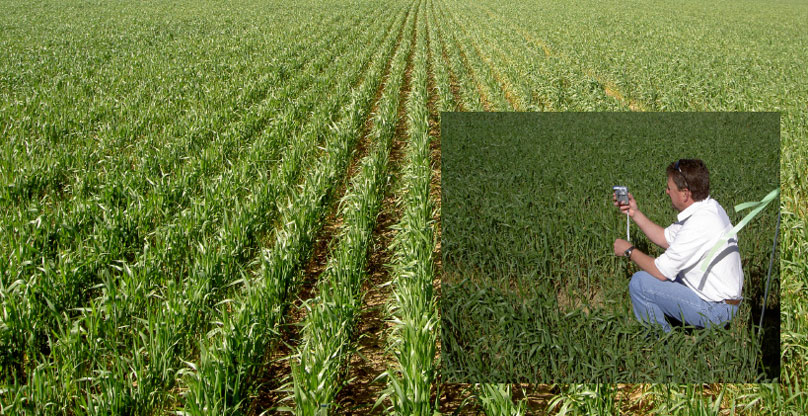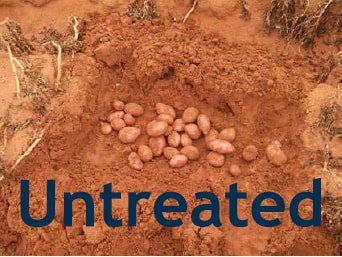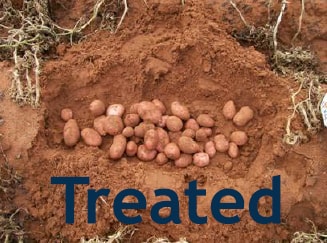Agricultural Trials
Northern Cape Vineyard Trial
A trial was conducted in the Northern Cape area of South Africa where AquaBoostAG was used on struggling young vines. There were 6 treated rows and 3 control rows. 3 of the treated rows were treated with 3L/ha of AquaBoostAG every 6 weeks and the remaining 3 rows were treated with 5L/ha of AquaBoostAG every 6 weeks.
In addition to visual differences, the first measurements were done using a SPAD meter which measured the amount of chlorophyll present in the leaves which can serve as an indicator of the overall condition of the plant. In general, healthier plants will contain more chlorophyll than less healthy ones.

The second measurement taken was the trunk diameter which is used to determine growth over the season.
The table below shows the results from this trial indicate a substantial increase in the growth as well as the health of the plants treated with AquaBoostAG:
| Treatment | Average trunk diameter increase | Average SPAD increase |
|---|---|---|
| AquaBoostAG30 @ 3l/Ha every 6 weeks | 18.1% | 1.3% |
| AquaBoostAG30 @ 5l/Ha every 6 weeks | 24.9% | 2.5% |
- We would like the thank Karsten Group for assisting us and providing the data during the trials.
Australian Vineyard Trial
A series of trials was commissioned to execute an independent Research & Analysis Report by a group of major Vineyard managers based in South Australia. 5 wineries participated in the trials with a total of 16 Ha of treated and 16 Ha of control area.
In addition to water control measurements, the field data was analysed using a series of soil condition and plant uptake laboratory analyses. This was independently checked by North Coast Testing Services in NSW, Australia.
The trials have universally demonstrated the following benefits of using AquaBoostAG30 in drip irrigation on the trial sites:
Economic Impact
- Saving on water usage by a minimum of 30% and the ability to manage water scheduling and plant uptake
- Savings on water costs commensurate with volume and the per litre cost for the specific source
- Saving on nutrient costs, usage and ability to incorporate nutrient and trace element requirements for particular soils and fruit varieties
- Saving on electricity costs conditional on the power supply cost schedule for the area of operation
- Potential saving on herbicide usage on a per application basis
- Ability to be incorporated with liquid fertiliser without creating separation of particles in fertilisers and therefore no blockages of drippers or need to apply separately
Soil Impact
During the trial period the areas to which AquaBoostAG30 was applied recorded the following changes in soil profile:
- Significant decreases in sodium
- Dramatic decrease in sodium absorption ratio
- Qualitative fostering of microbial activity
- Substantial decrease in electrical conductivity
- Decreases in nitrate nitrogen and re-mineralisable nitrogen
- Colwell potassium levels decreased
- Marginal increase in potassium absorption ratio
- Ability to incorporate in drip irrigation, saving the need to incorporate in soil and hence no disturbance of the adventitious (hair-like) root system near soil surface.
Technology and methods used
- Moisture monitoring: C-Probe (one for trial, one for control patch)
- Nutrient impact – Cardiometer - Weekly results (on sap and juice)
- Microbial activity
- AquaboostAG30 residue in soil and fruit
- Berry and Juice analysis – to PIRSA standards
- SAP analysis
- Initial salinity and movement of salts
- Colour
- pH, TA, Baume
- Dry tissue testing
- Pre-plant application and later application – effect on fruit at berry ripening stage
- Bud burst testing – application of product now
- Electricity costing
- Fertiliser costing
Australian Wheat Trial
The objective of the trial in West Australia was to evaluate under a replicated trial situation the effects of AquaBoostAG30 on wheat.
The trial was established within a program under the technical project management of an independent cereal agronomist and advisor from MEAG Soil Consultancy in Northam, West Australia.
Outlined in the table below are the outcomes for yield, protein, screenings and hectolitre weight. Results are averages across three replicates per treatment.
| Treatment | Times run | Yield (Ton/Ha) | Protein (%) |
|---|---|---|---|
| Control | 3 | 1.58t | 9.00% |
| AquaBoostAG30 @ 3l/Ha | 3 | 1.76t | 9.40% |
| AquaBoostAG30 @ 4l/Ha | 3 | 1.68t | 9.27% |
| AquaBoostAG30 FB @ 4l/Ha | 3 | 2.05t | 9.27% |
The two most significant outcomes from the trial are:
- The increase in yield over the control by the addition of AquaBoostAG30 Fulvic Blend (FB) at 4 litres per hectare. This increase represents an improvement of 29.75%. Significantly, this yield increase has been achieved whilst maintaining protein levels relative to the control.
- The improvement in root mass and the retention of moisture within the root zone by the AquaBoostAG formulation led to additional Nutrient efficiency release in the soil and thus plant uptake. This had the effect of increasing yield potential and protein maintenance.
Australian Potato Trial
The trials were conducted on a property in the Northern Mallee region of South Australia. There were 2 applications of 16 ha each. Trials were conducted on 3 types of Potatoes, namely Desiree, Rameal and Nadinel.
Soil moisture monitoring was undertaken using Sentecs Enviroscan continuous logging capacitance sensor. Sap analysis using the Horiba Cardiometer was undertaken on a weekly basis in the potato crop.

Previous studies into these soils show that the farm area is dominated by light sandy soils with relatively high hydraulic conductivity. These soils are highly regarded for the production of premium white and red skinned potatoes.
The following table shows the effects of the AquaBoostAG on the yield:
| Cultivar + Treatment | Yield (kg/m²) | Yield (tubers/m²) |
|---|---|---|
| Nadine Control | 2 | 18 |
| Nadine Treated | 5.7 | 36 |
| Rameal Control | 6.4 | 33 |
| Rameal Treated | 7.1 | 45 |
| Desiree Control | 3.6 | - |
| Desiree Treated | 6.4 | - |
Yield
In all varieties the numbers of premium potatoes per metre was increased as a result of using AquaBoostAG30 during the growing cycle. By minimising the degree of fluctuation in the root zone greater tuber set occurred in all three varieties with a subsequent yield increase.
Soil Moisture
Soil moisture data from using the Enviroscan shows less soil moisture variance in the root zone of the treated areas. The significance of minimising fluctuations in soil moisture levels in the root zone or banked area, are important issues facing potato growers.
The use of AquaBoostAG30 in this trial showed that changes in the hydraulic properties of water through the soil, and the ability to influence soil moisture levels in the top 20cm of the soil bank, plays an important role in increasing plant production of premium quality tubers.
These pictures show 1 meter plots which were dug from within the treated and non-treated areas. As can be seen, there is a significant degree of variance between the 2 plots.


